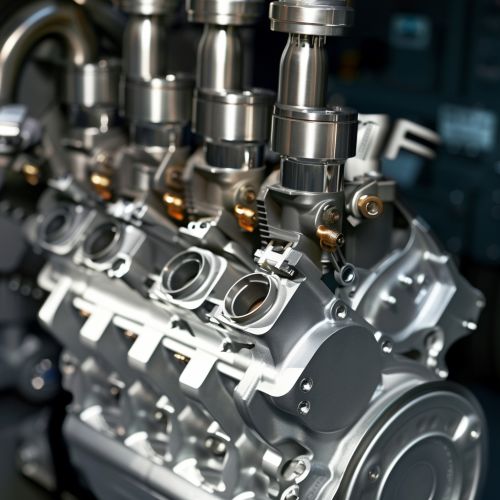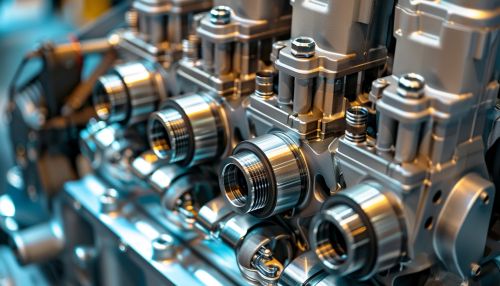Engine
Introduction
An engine is a machine designed to convert one form of energy into mechanical energy. Heat engines, including internal combustion engines and external combustion engines, burn a fuel to create heat, which then creates a force. Electric motors convert electrical energy into mechanical motion, pneumatic motors use compressed air, and clockwork motors in wind-up toys use elastic energy. In biological systems, molecular motors, like myosins in muscles, use chemical energy to create forces and eventually motion.
History
The concept of the engine dates back to ancient times. The first rudimentary engines were the steam engines of the 1700s, which were used for a variety of tasks such as pumping water, grinding grain, and powering locomotives. The Industrial Revolution in the 18th century saw the development of more complex engines, including the internal combustion engine and the electric motor.
Types of Engines
There are several types of engines, each with their own unique characteristics and uses. Some of the most common types include:
Internal Combustion Engine
The internal combustion engine is an engine in which the combustion of a fuel occurs with an oxidizer (usually air) in a combustion chamber. In an internal combustion engine, the expansion of the high-temperature and high-pressure gases produced by combustion applies direct force to some component of the engine, such as pistons or turbine blades or a nozzle, and by moving it over a distance, generates mechanical work.
External Combustion Engine
An external combustion engine is a heat engine where a fuel is combusted away from the engine, using the heat to produce steam which then powers the engine. Examples include steam engines and Stirling engines.
Electric Motor
An electric motor is an electrical machine that converts electrical energy into mechanical energy. Most electric motors operate through the interaction between the motor's magnetic field and electric current in a wire winding to generate force in the form of torque applied on the motor's shaft.
Pneumatic Motor
A pneumatic motor or compressed air engine is a type of motor which does mechanical work by expanding compressed air. They have existed in many forms over the past two centuries, ranging in size from handheld turbines to engines of up to several hundred horsepower.
Engine Components
Engines are complex machines with many components, each of which plays a crucial role in the engine's operation. Some of the main components of an engine include:
Cylinder
The cylinder is the space in which a piston travels. The more cylinders an engine has, the more powerful it is.
Piston
A piston is a component of reciprocating engines, reciprocating pumps, gas compressors, hydraulic cylinders and pneumatic cylinders, among other similar mechanisms. It is the moving component that is contained by a cylinder and is made gas-tight by piston rings.
Crankshaft
The crankshaft is the part of an engine which translates reciprocating linear piston motion into rotation.
Connecting Rod
The connecting rod is the part of an engine which connects the piston to the crankshaft.
Engine Operation
The operation of an engine involves a sequence of stages known as the engine cycle. The most common engine cycle involves four stages: intake, compression, combustion (power), and exhaust.
Intake
During the intake stage, the piston moves down the cylinder and draws in a mixture of fuel and air.
Compression
During the compression stage, the piston moves back up the cylinder and compresses the fuel-air mixture.
Combustion (Power)
During the combustion stage, the compressed fuel-air mixture is ignited, usually by a spark plug for a gasoline engine or by heat and pressure for a diesel engine. The resulting explosion forces the piston back down the cylinder.
Exhaust
During the exhaust stage, the piston moves back up the cylinder and expels the spent fuel-air mixture from the cylinder.
Engine Efficiency
Engine efficiency, also known as thermal efficiency, is a measure of how effectively an engine converts the energy stored in its fuel into useful work. The higher the efficiency, the less fuel is needed to produce a given amount of work. Engine efficiency can be improved in a number of ways, including through the use of turbochargers, advanced ignition systems, and more efficient fuel injection systems.
Engine Maintenance
Proper maintenance is crucial for ensuring the long-term health and performance of an engine. Regular maintenance tasks include changing the oil, replacing the air filter, replacing the spark plugs, and checking the engine for leaks or other problems.
See Also
- Internal combustion engine
- External combustion engine
- Electric motor
- Pneumatic motor
- Cylinder (engine)
- Piston
- Crankshaft
- Connecting rod


